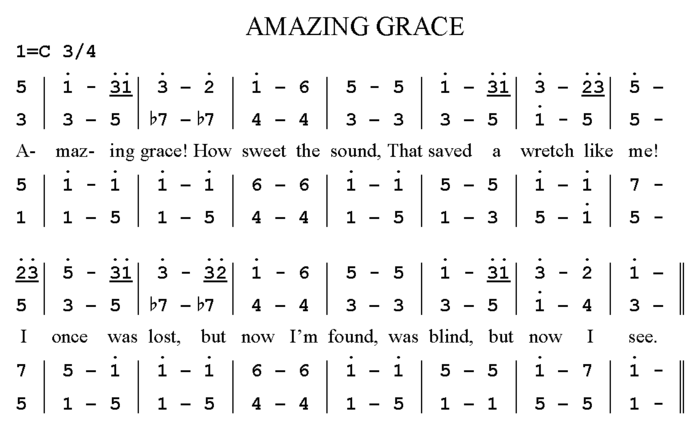Chinese numeric notation
Chinese numeric notation or Jianpu notation ( Chinese 簡譜 / 简谱 , Pinyin jiǎnpǔ ; literally: "simplified notation") is a musical notation system with Arabic numerals that has been used in China since the early 20th century . It is used for both monophonic and polyphonic music notation. It is derived from the French system called Galin-Paris-Chevé (i.e., the Chevé number notation ).
For this musical notation of numbers, digits are mainly used (from 1 to 7, with 0 as a pause), along with additional characters, including many from standard Western music notation.
notation
grades
The numeric tone writing can be used as the basis for the tonic sol-fa (see Solmisation and Solfège ), the numerals 1, 2, 3, 4, 5, 6, 7 stand for the 7 notes of the scale, they become do , re , pronounced mi , fa , sol , la , si , pauses are indicated by the number 0. The digits from 1 to 7 correspond to the diatonic major scale.
Solfège: do ré mi fa sol la si Jianpu-Notation: 1 2 3 4 5 6 7
Octavings
Points above or below the notes indicate whether they are an octave below or above the original pitch. The number of points corresponds to the number of octaves. For example, the number "6" with a dot underneath represents an octave lower. The scales are thus represented as follows:
•
Durskala: 1 2 3 4 5 6 7 1
Mollskala: 6 7 1 2 3 4 5 6
• •
Accidentals
When a sound is increased or to be decreased, to write to the left of the number one increase sign (#) or a humiliation characters ( b ), such as # 1 or b 2. Accordingly, there are natural signs . The key is indicated at the beginning of the piece.
Time signature
The time signature is indicated at the beginning of the piece with a short slash between two Arabic numerals, for example “3/4”, the upper digit indicates the number of basic beats, the lower digit the duration of each beat. “2/4” = two-four time, “3/4” = three-four time, “4/4” = four-four time, “6/8” = six-eight time, etc. In the piece itself, the bars are indicated by longer vertical lines.
key
The key of a piece is indicated at the beginning by indicating which key is the basic level. For example, 1 = D means that the pitch of the basic note of the piece corresponds to the note D on the piano keyboard, the other notes analogously; B = B major; b B = B flat major etc.
Note values
A single digit corresponds to a quarter note. Short horizontal lines following the note extend the note value. E.g. on the first tone level:
- 1 quarter note
- 1- half note
- 1-- dotted half note
- 1 --- whole note
- 1 ----- dotted whole note
- Digit followed by a dot: dotted quarter
Underlining shortens the note value. They correspond to the flags in conventional notation.
- Underlining: eighth note
- Two underlines: sixteenth note
- Three underlines: thirty-second note
- Four underlines: sixty-fourth note
Rhythmic notation
In rhythmic notation, e.g. B. for drums , small or capital X letters are used instead of the note numbers, e.g. B .:
4/4 > > (klatschen:) | X X X X X | X X X X 0 X X ||
Ties
Ties are notated as in traditional notation, with a bow from the first to the last note.
Slurs
Slurs are notated as in traditional notation, with a slur from the first to the last note.
A V-like character above the notation line, on the other hand, indicates a brief respite.
Ornaments
The following decorations are used in Jianpu notation (selection):
Long suggestion
The long suggestion is usually noted with an ascending or descending rounded arrow between the two notes in question.
Short suggestion
There is also the short suggestion . It is noted by underlining the corresponding note number twice and adding a curved line in the direction of the note line above the base line in lower case.
trill
The trill , as in the conventional notation with tr noted. It is noted above the note number, the tones of this note quickly alternating with the one above. A note number can be written above the trill, in which case the trill is performed by trilling over it with the corresponding specified note.
Notation example
See, for example, the song Amazing Grace by John Newton in the Jianpu version and the traditional notation in the five-line staff:
literature
- Yang Yinliu (Ed.): Zhongguo yinyue cidian (Dictionary of Chinese Music). Beijing 1984
- Zhang, Zuozhi: History, Use, and Meaning of Chinese Numeric Notation , A Musicological and Educational Study, 1997.
- Martin Gimm : China . In: A. Jaschinski (ed.), Notation (MGG Prisma), Kassel, Bärenreiter 2001, Sp. 254-267, 304-305.
See also
- Norwich sol-fa system
- Music notation system by Jean-Jacques Rousseau
- Jean-Jacques Souhaitty
- Aimé Paris
- Sarah Ann Glover
- John Curwen
- Shen Xingong
Web links
- Yinyue he Jianpu zhishi - Chinese
- An Editor For Numbered (Simplified) Music Notation (JianPu) - English
Footnotes
- ↑ After the three people Pierre Galin (1786-1821), Aimé Paris (1798-1866) and Émile JM Chevé (1804-1864).
- ↑ Which itself looks back on a longer history.


